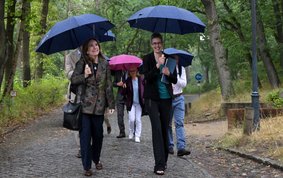Our team is dedicated to understanding and evaluating seismic hazards and risks through a rigorous scientific and quantitative approach. By bringing together experts from multiple disciplines, we develop comprehensive models that assess earthquake risks at every stage of the evaluation process. This includes studying earthquake occurrence using seismicity models and physics-based approaches, predicting ground shaking through seismic motion models, analyzing site effects that amplify shaking, and assessing the exposure and vulnerability of buildings and infrastructure.
We develop research projects that advance our seismic risks understanding, develop software for testing seismic motion prediction models, lead the World Stress Map, and contribute to the European Seismicity Catalogue. We are also at the forefront of innovation, exploring new methods such as artificial intelligence, fibre optic, and smartphone-based seismic monitoring. Our research seamlessly integrates into international projects, bridging fundamental science with practical applications.
A key focus of our work is quantification of uncertainties in seismic hazard assessments, particularly in regions with low to moderate seismic activity (intraplate zones). Our expertise extends beyond natural tectonic earthquakes to include induced seismicity, which can result from underground storage operations or geothermal energy projects. We participate in international training programs, knowledge-sharing initiatives, and we are committed to transparency and openly share our data, computational models, methodologies, and findings. This ensures that our research benefits both scientific communities and society as a whole.













![[Translate to English:] [Translate to English:] Themenbild Störungsreaktivierung und induzierte Seismizität](/fileadmin/_processed_/8/e/csm_Fault_2_0dcebba0d9.jpeg)
![[Translate to English:] [Translate to English:] Themenbild Spannungszustand der Kruste](/fileadmin/_processed_/e/7/csm_Stress_2_ba698c1d24.jpeg)
![[Translate to English:] Themenbild Seismic ground motion modeling](/fileadmin/_processed_/b/3/csm_GMM_23c3c936e0.jpeg)

![[Translate to English:] [Translate to English:] Themenbild Dynamische Expositionsmodelle](/fileadmin/_processed_/6/3/csm_Dynamic_exposure_55f1a6ee86.jpeg)
![[Translate to English:] [Translate to English:] Themenbild Mehrfachgefährdung und Kaskaden](/fileadmin/_processed_/5/a/csm_Multi_Hazard_d20d113ef0.jpeg)
![[Translate to English:] Excerpt from a map of the Phlegraean Fields near Naples, Italy: Left: Red dots mark smartphone sensors, yellow triangles mark fixed seismological stations. Right: The area is coloured in shades of yellow, red and purple according to the amplification of seismic waves.](/fileadmin/_processed_/3/b/csm_20251028_PM_Smartphone-Earthquake_Slider_df35c7efba.jpeg)



![[Translate to English:] Map Myanmar](/fileadmin/_processed_/b/4/csm_20250328-1300-Slider-01_EarthquakeExplorer-GFZ_eebce5f8ab.jpeg)



![[Translate to English:] René Steinmann and Jana Täumer](/fileadmin/_processed_/d/e/csm_20240415_Discovery-Fellows_fe0e84fc5e.jpeg)
